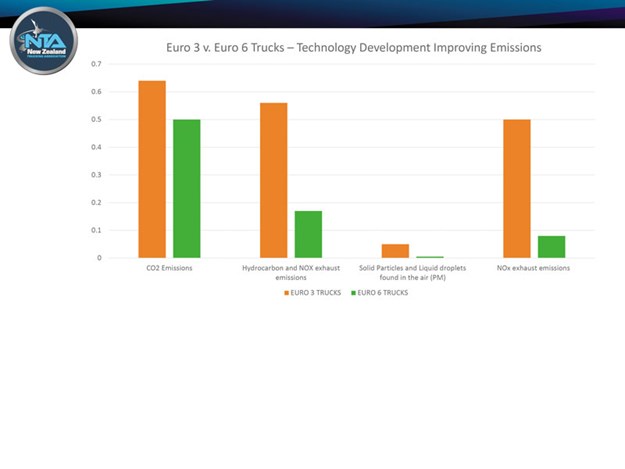Comment: Encouraging new technology in the trucking industry
New vehicle technologies help drivers to safely operate their truck, reduce the number of movements required to complete a freight task, and minimise carbon emissions and road infrastructure impacts for the community
.jpg) |
|
The trucking industry is embracing trials of alternative fuels
|
New technology is fast revolutionising the trucking industry, with improved lifesaving safety features the match of any new car, and with vastly improved environmental performance that has seen diesel particulate matter reduced by 95% and a significant reduction in fuel use.
New safety technologies available on new trucks include adaptive cruise control, forward collision warning, autonomous emergency braking (AEB), lane departure warning, electronic braking systems, electronic stability control (ESC), telematics, fatigue monitoring systems, pedestrian and cyclist detection systems, and blind spot cameras.
 |
|
Vastly improved environmental performance has resulted from Euro 6 technology
|
Vastly improved environmental performance has resulted from Euro 6 technology being used since 2015 in the newest heavy trucks, especially when you compare this technology to older trucks, many running Euro 3 technology. In 2018, the average age of the New Zealand heavy fleet was 17.8 years.
The trucking industry is embracing trials of 100% EV metro delivery trucks, and trials of alternative fuels including biodiesel, battery EV, and hydrogen cell technology in heavy trucks. It is important to remember though that this transition to alternative forms of fuel for heavy trucks will take many years to be widely adapted by the trucking industry.
This new technology is still in its preliminary stages of development, and with presently no clear technology winner as the industry preferred solution, especially for long distance heavy trucks.
To be adapted widely by the trucking industry will require vehicles to be produced with increased economies of scale to bring capital costs down to the levels of existing diesel technology, and for networks of refuelling stations to be established across the country. So, in summary, diesel heavy trucks will be here for many years yet.
This has created an opportunity for Government to encourage the uptake of Euro 6 technology heavy trucks as an interim solution that will offer an earlier take up of life saving safety features, and a greatly improved environmental outcome with cleaner and more fuel-efficient engine technology.
One does not have to look far for an example of how Government can provide that encouragement. In March 2020, the Australian government introduced accelerated depreciation measures as an incentive to businesses with an aggregated turnover of less than $500 million.
The scheme allows businesses to deduct the cost of a new depreciating asset at an accelerated rate via their tax return for the year the asset is first used. If your turnover is less than $500 million, an example would be a new curtainsider truck and trailer unit costing $600,000 - you can claim 50% ($300,000) of the unit value under the scheme in the first year.
In addition, you can claim standard depreciation rates on the remaining $300,000 in that first year. For smaller businesses with a turnover less than $10 million, you can claim 57.5% depreciation (up to $150,000 claim) in the first year on new assets costing more than $150,000.
In 2020 the Australian National Heavy Vehicle Regulator (NHVR, equivalent to the Ministry of Transport in New Zealand) released a blueprint to support manufacturers and trucking operators to incorporate the latest safety technology into new and existing heavy vehicles. The blueprint has five key areas of focus for heavy vehicles:
- Advocate for the increased:
- Harmonisation of vehicle standards to allow for the latest designs from origin markets, and
- Fitment of safety and environmental technology from those major market designs.
- Relax access and use limits for vehicles fitted with the latest environmental and vehicle safety technology.
- Ensure in-service requirements maximise the benefits of mandated technology.
- Empower industry to make informed purchasing decisions.
- Educate industry about vehicle safety and environmental technology.
- New vehicle technologies help drivers to safely operate their truck, reduce the number of movements required to complete a freight task, and minimise carbon emissions and road infrastructure impacts for the community.
- Similar schemes if introduced into New Zealand would certainly encourage trucking operators to purchase new trucks with the latest safety and environmental technologies. That has got to be good for everyone.
- NTA supports the uptake of safer and more environmentally sustainable trucking technology.
The New Zealand Trucking Association champions road safety on behalf of the transport industry and since 2017 we have had the Road Safety Truck on the road. This has only been possible because of the generous industry support from all the sponsors.
This truck has enabled us to reach out to communities and schools to promote behaviour change when sharing the road with heavy vehicles. Highlighting the capabilities of a large vehicle showing them the blind zones, the time it takes to stop and how much space they need to turn is embraced by the public.
The Road Safety Truck also delivers Driver Health and wellbeing programmes to the trucking industry. Soon to be launched in New Zealand in partnership with the Australian Trucking Association is the SafeT360 virtual reality road safety programme, aimed at 16–25-year-olds. To date, more than 41,000 people have been through the programmes.
Find new and used trucks for sale in NZ
Keep up to date in the industry by signing up to Deals on Wheels' free newsletter or liking us on Facebook.





.jpg)


.jpg)


-(1).jpg)
-(1).jpg)
.gif)
.jpg)
.jpg)

